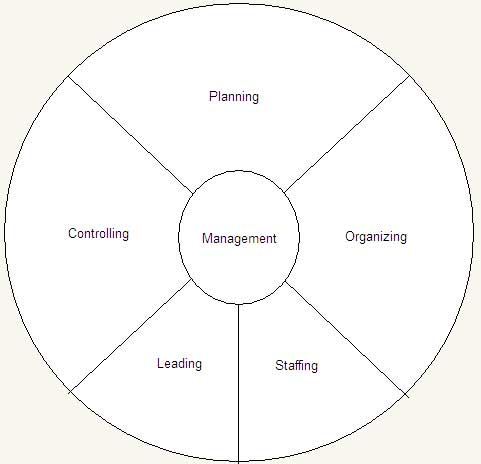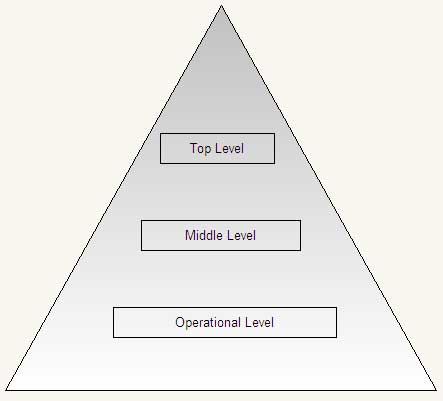For the better part of our productive life, most of us are a part of one organization or another. The organization that we are part of may be very structured, like the armed forces or corporate entities or it may be loosely structured like a neighborhood cricket team. Even though organizations may be of different types, they have some common characteristics like the existence of a common goal/mission towards which each member of the organization works for, a plan or an agenda to make the goal/mission a reality and the utilization of resources to achieve the goal.
Managementis the practice of shaping organizations and its people to achieve its goal/s and mission. Management generally involves the following activities or techniques,
- Planning: Making informed decisions about what to do in the future.
- Organizing: Making arrangements to fulfill the plan requirements.
- Staffing: Employing the right people for the right job.
- Leading: Influencing the members of the organization to move towards the common goal of the organization.
- Controlling: Making checks to find the deviations/hold ups and taking corrective action/s.
A manager in the course of his duties performs the above activities effectively to do justice to his profession. However, it will be worthwhile to mention here that management itself is an evolving concept. Some consider it as an exact science and others consider it as art. Actually, it is based on practice. The practice of management makes it what it is. The other important criterion for defining management is that management as a profession is associated with the most important activity of an organization and that is decision-making. The only distinguishing attribute of a manager in an organization is his authority and capability to take decisions. This quality makes the profession distinct.
Decisions however cannot be taken in isolation. To take a decision a manager needs information on the problem on which decision is required, information to help generate alternatives, information about the different alternatives and also information about the implications of choosing the alternative. At each phase of the decision-making process, a manager needs information and this is the vital link between management and information. Without information a manger’s ability to take decision is seriously impaired.

We’ll be covering the following topics in this tutorial:
Levels of Management
Management however, is not a monolithic entity. Every manager has a distinct role and even though all managers take decisions, some managers take more important decisions than others, which have a greater impact on the entire organization. Management actually is itself divided into levels. Each level of hierarchy has got specific roles, a level of authority, responsibility, accountability and deliverables. Decision-making therefore is of different levels of complexity and impact at the different levels of management. Hence, information requirement is also different for each level.
Antony (1965) has suggested a framework that is widely accepted in which management is divided into three levels-top, middle and operational. Each level has a distinct role and responsibility and the structure is pyramidal. This means that in middle management there are less number of managers than at the operational level and in the top level there are still lesser number of managers than even the middle level. However, the responsibilities grow exponentially as one move up the ladder of the pyramid.
The top level managers are responsible for planning and other strategic activities. Ideally this top management constitutes the CEO, the board and other heads. The top management decision would include strategic issues that will have a lasting impact on the whole organization like the decision to open a factory in say China or the decision to launch a new product, etc. The middle level works on tactical issues. They are responsible for the smooth functioning of the company and also to pass on critical information to the top management about markets and competitors, etc. The middle level managers take decisions regarding say, whether to have a preventive maintenance in the factory or have breakdown maintenance. As can be understood their impact even though important, is not a lasting impact. In different organizations this middle level function is handled by different designated people. In a large firm a Vice President may also perform the role of a middle level manager and in some cases the General Manager may perform a middle level role. The operational management takes decisions on operational issues like taking decisions on which worker will be deployed for what work, etc. They are basically implementers of broad decisions taken by the higher tiers of management. For example, if the top management has decided to make a new product using the same assembly line of the organization then the middle level managers have to completely reschedule the production planning and scheduling. This new production plan will then pass on to the supervisors at the operational level whose job will be to see to it that the broad objectives of the plan remain intact. They can however decide (like decisions on floor level action, decisions on manpower decision on overtime) on the best way to make the plan a reality.

The tier-wise structure of management helps in maintaining order. Even though in modern organizations the levels have blurred a bit, the broad contours remain. However, in different cultures the levels of management take on new meaning like in Japanese companies. In Japanese companies the shop floor level managers have a much greater authority than in other American or Indian companies. This has got more to do with cultural issues than anything else.
The role of information is vital at each level. As is evident, each level takes decisions with varying degree of complexity and impact. However, all the decisions are vital for the smooth functioning of the company. Each level requires a very distinct type of information. At the shop floor level one needs operational information about people, processes, guidelines, etc. All such information is very structured. The manager who goes through the process of taking the decision at this operational level knows that the decision that he is going to take has been taken by him or someone before him several times. Uncertainty about the outcome is minimal. Even then to take the decision, he needs information in a structured format. Like say, at the shop floor level if a supervisor has to decide on shutting down a machine after observing deviations in the output and behavior of the machine he needs to know what the ideal characteristics of the machine are, what the deviation characteristics are and what needs to be done at the first onset of deviation. This information has to be made available to him on a real time basis for him to take that simple decision of shutting the machine. Similarly, for other levels, the same logic holds true. Without information, managerial decision-making quality is severely impaired. In fact, at the higher tiers of management the implications of a decision and wrong decisions at that are much more severe than at the operational level.
Characteristics of Different Levels of Management
The different levels of management have different roles and responsibilities. Each such level works within its own boundary but with the objective of attaining the overall corporate goal.
Characteristics | Top Management | Middle Management | Operating Management |
Planning activity | Heavy | Moderate | Low |
Control activity | Low | Heavy | Heavy |
Organizing activity | Low | Heavy | Heavy |
Leading activity | Heavy | Moderate | Low |
Decision-making Complexity | Heavy | Moderate | Low |
Problems handled | Unstructured and semi structured | Semi structured/ structured | structured |
Type of information required for decision making | Strategic information, unstructured/semi structured from both within the organization and outside organization environment | Tactical and structured/semi structured information from within the organization | Operational and structured information from within the organization |
Impacts and outcomes | Long-term and organization wide | Medium term | Short-term |
Understanding of the line of business | High | Very high | Medium to low |
Understanding on the business environment | High | High to medium | Low |
Understanding on the Compition | High | High to medium | Low |
 Dinesh Thakur holds an B.C.A, MCDBA, MCSD certifications. Dinesh authors the hugely popular
Dinesh Thakur holds an B.C.A, MCDBA, MCSD certifications. Dinesh authors the hugely popular